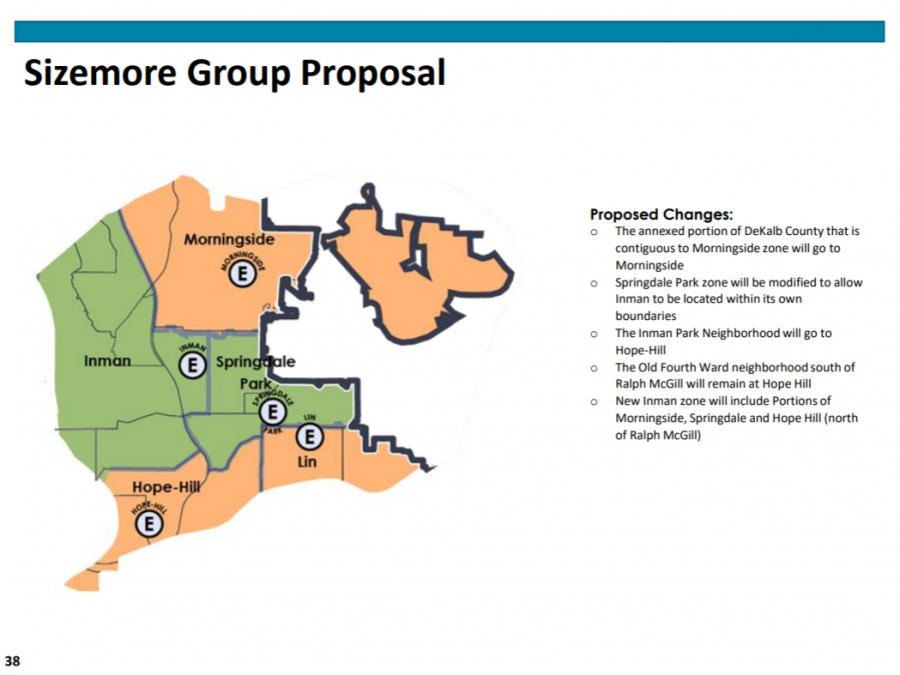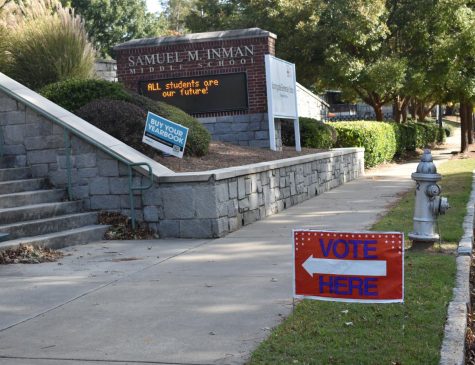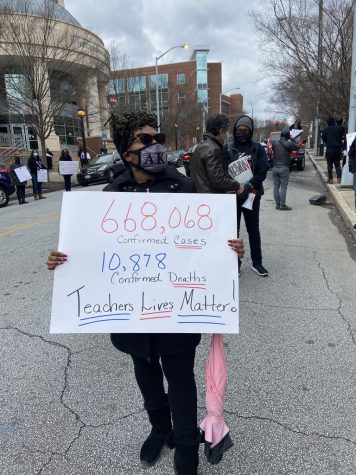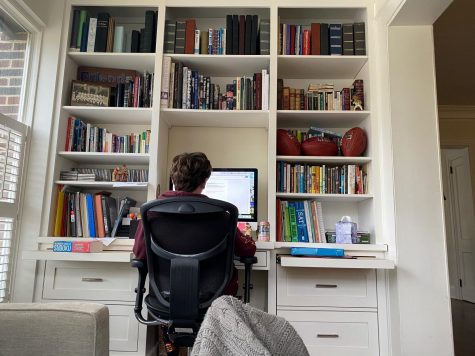Head to Head: What should APS do with the vacant Inman facility?
April 30, 2021
The Inman Middle School facility was left vacant by the renovation and reopening of the David T. Howard facility, and now is a temporary site for Morningside Elementary School. After Morningside’s renovations are complete, the building will be vacant and available for alternative use. The question is: what should that alternative use be?
In an APS survey asking stakeholders their number one priority for the school system, a combined 47 percent of respondents replied with a concern about future capacity and growth. The Inman facility has the potential to stave off future overcrowding by reallocating students to different schools. APS has outlined two overarching options: turning Inman into a new, kindergarten through fifth grade elementary school (for which there are four separate rezoning plans) or converting it into a fourth and fifth grade academy. The elementary school option was proposed by the Sizemore Group, an architectural group contracted by APS to help plan future use of facilities.
Inman should turn into a fourth and fifth grade academy
When discussing school redistricting and restructuring, there’s no way to satisfy all stakeholders. Issues such as the future of the old Inman Middle School facility will usually cause major contention in the community. However, these tumultuous decisions can be an avenue for real, positive change. Implementing the fourth and fifth grade academy option would give the district an opportunity to address many of the issues the Grady cluster currently faces.
A huge advantage of the fourth and fifth grade option is that it won’t require rezoning. In all of the current options for creating an Inman Elementary School zone, zones would be split in various ways to create another elementary school to feed into what is now Howard Middle School.
The fourth and fifth grade option would keep all zones exactly as they are, and funnel all fourth and fifth graders in the district to Inman before continuing to Howard for sixth grade.
A fourth and fifth grade academy would also address concerns of lower overcrowding at the elementary school level. Inman would have projected overcrowding as a middle school, but unlike most of the previously overcrowded campuses, it has room to grow.
In a survey by the Council of Intown Neighborhoods & Schools, 45 percent of respondents marked their primary goal to address capacity growth in the Grady Cluster as ensuring elementary schools are neighborhood schools (schools children can easily walk to). Many parents in the Grady cluster are used to walking their children to school for their entire K-5 elementary school education. If Inman was turned into a fourth and fifth grade academy, only about 35 percent of students would have a mile or less walk to school. In each of the proposed K-5 options, over 50 percent of students would have a walk less than a mile.
However, while walkability may be important to some parents, but it might not be the most important indicator of a neighborhood school. The fourth and fifth grade academy has the potential to redefine our idea of a neighborhood to include the entire cluster. The ideal neighborhood school would have students from all over the Grady cluster, exposing children to more diversity and viewpoints than are available in separate elementary schools.
Part of the strength of our Grady community is its breadth in walks of life. Look at Grady’s motto, “Individually we are different, together we are Grady.” Bringing students together earlier would foster the ties between the district as a whole, bringing value and strength to students’ and parents’ experiences and the life of the cluster.
Having a fourth and fifth grade academy would mean the district would be able to pool resources and ensure children get more equal opportunities earlier (which is something 28 percent of survey respondents ranked as their first or second priority in the CINS survey).
Not all elementary schools in the cluster are currently performing at the same level of readiness, progress and content mastery, according to the Georgia Department of Education’s 2019 College and Career Ready Performance Index. Though bringing students together will not solve all racial and socioeconomic disparities that exist in APS elementary schools, it will further standardize opportunities in the cluster because kids will be at the same school earlier in their education. With Inman serving as a fourth and fifth grade academy, more children will have the same access to gifted, on-level and remedial classes. This isn’t a solution to the current achievement gap, but hopefully, it will create fewer disparities in honors and AP classes later in middle and high school.
While the elementary school option would break up current school zones and divide the district community more, the fourth and fifth grade academy would allow for a more developed, more closely-knit Grady cluster community.
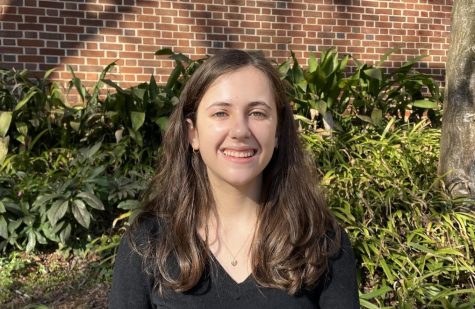
Anna Rachwalski is a senior and this is her third year writing for the Southerner. Outside of the newspaper, she is president of the Quiz Bowl team, is...
Inman should turn into an elementary school
The conversation around what to do with Inman is not an easy one to answer, as parents, stakeholders and community members try to have their say in the building’s future. However, turning Inman into a new elementary school for the cluster is the solution that would best meet the needs of all community members.
In contrast to the fourth and fifth academy, the elementary school proposal ensures elementary schools remain neighborhood schools and keep the schools close to the communities they serve. In a survey of 1,083 Grady cluster families by the Council of Intown Neighborhoods and Schools, 45 percent ranked “ensuring elementary schools are neighborhood schools” as their first or second priority in primary goals in addressing capacity growth in the cluster. This was the top response in the survey.
Creating a new school would mean zoning for every elementary school would be smaller, allowing children to form close connections with peers who live in their neighborhood and giving the community greater involvement with each school.
Another benefit to the elementary school option is that it allows for more walkability. In a separate survey conducted by APS of 469 parents, staff and community members, 27.23 percent of respondents chose walkable communities as their number one priority for future facility considerations, the greatest response in the survey.
If Inman was converted into an elementary school, a projected 51.3 to 58.1 percent of students would be able to walk to school, compared to only about 35.4 percent of students with the fourth and fifth grade academy option. Walking to school has many benefits to students, including a greater sense of alertness leading to higher academic performance. Additionally, having a school close enough to walk to increases attendance and removes possible transportation barriers.
While these are both important factors, turning the Inman facility into an elementary school solves APS’ projected issue of overcrowding at Mary Lin, Morningside and Springdale Park elementary schools. By pooling students from the cluster’s current elementary schools, all cluster elementary schools will be smaller, giving students and teachers more breathing room. While the fourth and fifth grade academy option will alleviate this problem at elementary schools, it is projected to cause overcrowding at Inman.
Smaller elementary schools mean smaller class sizes and more individualized focus on students, which is beneficial in the long run. Additionally, if Inman is turned into a new elementary school, students will have less transition in their K-5 years, adding more stability into these student’s lives and allowing them to form closer ties with their schools and communities.
While a benefit to the fourth and fifth grade academy option is increased diversity among students at an earlier age, several parents are concerned that this may come at the expense of equity. At Hope Hill Elementary School, a largely neighborhood school in the Grady Cluster, parents believe that the community built a great support network across students of all races and socioeconomic status. The concern is that with the fourth and fifth grade proposal, these students will miss out on this support network in their later elementary years. If the district were to move on with this proposal, intentional efforts would have to be made to ensure these students are receiving the same level of support they had before.
The most prevalent drawback to the Inman Elementary proposal is rezoning within the Grady cluster. Rezoning is a conversation no one likes to have, but is a conversation that has been long put off and is now necessary for both APS and the community to face. Currently, APS has several different options for how these neighborhood lines will be drawn. However, parents can take reassurance in the fact that these rezoning plans keep all children both inside the district and within the Grady Cluster. Rezoning is not fun, but it provides an opportunity to come together and create a new school community.
No one likes change, and no proposal will fully satisfy everyone, but we must come together as a district to find a solution that meets the majority of the cluster’s needs. Turning Inman into an elementary school is a solution that does what it needs to, and provides a new chance to create smaller, stronger district communities.

Lanier is a senior and this is her third year on staff with the Southerner. In addition to writing for the Southerner, Lanier is editor of Latin club,...
